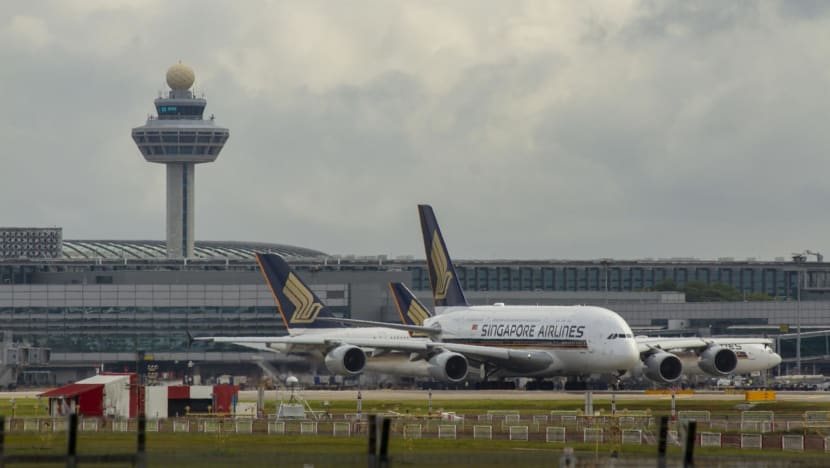Commentary: Why impose a sustainable aviation fuel levy on passengers flying from Singapore?
As a major aviation hub, Singapore can leverage travellers transiting through to pay for the move towards sustainable aviation fuel, says NUS Energy Studies Institute’s Roger Fouquet.

Singapore Airlines planes at Changi Airport in February 2020. (File photo: iStock)

This audio is generated by an AI tool.
SINGAPORE: The Civil Aviation Authority of Singapore (CAAS) is planning to introduce a levy on air travel to promote the use of sustainable aviation fuel (SAF).
Starting in 2026, the levy will be set to target for 1 per cent of the aviation fuel used in Singapore to be SAF. Thereafter, CAAS aims to raise the SAF target to 3 to 5 per cent by 2030.
CAAS anticipates that an economy class passenger on a direct flight from Singapore to Bangkok, Tokyo and London to be S$3, S$6 and S$16 respectively. While the levy will remain constant in any year even with fluctuations in the actual price of SAF, it will vary according to the distance travelled and class of travel. Given that premium class passengers take up more space and make the plane less fuel-efficient, they will pay higher levies.
The reaction to CAAS’s announcement has been mixed. Some netizens have complained about having to pay more to travel. Others are concerned that the money will simply go into a private company’s profits.
On the other hand, some netizens see the levy as a positive step, understanding the need to pay more for sustainable alternatives. Inevitably, introducing a green tax is unlikely to be popular, but there are reasons for it.
A POLLUTING INDUSTRY
Aviation in Singapore is responsible for large amounts of pollution. According to 2023 data from the International Energy Agency, Singapore’s aviation fuel use was about 9.8 million tonnes of oil equivalent. This translates into about 28 million tonnes of carbon dioxide emissions, which is exceptionally high for the country’s size and population.
In 2021, Singapore generated 50 million tonnes of carbon dioxide emissions. How can that be?
Officially, fuel bunkers for international aviation lie outside Singapore’s jurisdiction and responsibility - since a 1947 treaty to promote the aviation industry. As a result, these 28 million tonnes of emissions from international air travel are not counted. However, if they were included, national emissions in Singapore would increase by 56 per cent.
Certainly, these emissions are not only caused by Singaporeans. Changi is a major international hub. This fact can be a problem or an advantage, if harnessed effectively. Before discussing how, it is worth noting efforts to decarbonise aviation.
CARBON PRICING ON AIR TRAVEL
Aviation is seen as a hard-to-decarbonise sector. For instance, contrary to cars, electric planes are in their infancy and there are doubts about their potential to ever have sufficient power or range to compete with current jumbo jets.
This is why strategies to deal with the growth in air travel include blending aviation kerosene with biofuels and imposing forms of carbon pricing on air travel.
It is important to remember that carbon dioxide emissions inflict a cost on us all, particularly on lower-income countries vulnerable to climate change. The objective of carbon pricing and other environmental taxes is for the polluter to pay for the damage caused.
At present, few countries impose environmental taxes on air travel. Instead, air travellers can voluntarily pay for offsets from their carbon dioxide emissions. However, a Swedish study published in 2022 found that less than 5 per cent of air travellers pay to offset the damage they cause.
ENCOURAGING THE GROWTH OF SUSTAINABLE AVIATION FUEL
With that in mind, authorities are prioritising the adoption of sustainable aviation fuel to decarbonise the aviation sector. SAF is produced from waste fats, oils and greases, municipal solid waste, agricultural and forestry residues. Compared with conventional jet fuel, SAF can reduce carbon emissions by up to 80 per cent.
At present, SAF only accounts for 0.1 per cent of aviation fuel consumption. The main reason is that it is not yet commercially viable. The growth of SAF and its associated industries needs to be subsidised.
Singapore’s ambition is to develop a SAF industry that can reduce aviation’s carbon footprint. Because Changi Airport is a major hub, it can leverage travellers transiting through Singapore to pay for SAF.
As SAF development will benefit from economies of scale, foreign travellers would be helping to drive down the costs and to develop Singapore’s SAF industry.
Crucially, it is imperative that SAF is genuinely “sustainable”. They are not meant to compete with food crops, require incremental resource usage such as water nor lead to deforestation and biodiversity loss. It will be important to monitor how much carbon and environmental damage is generated from the production, distribution and use of SAF.
SAF is no silver bullet. It is doubtful that SAF will replace existing aviation fuel for a long time. Given its hard-to-abate status and global air travel potentially tripling over the next 25 years, emissions from aviation are likely to continue rising to 2050 and beyond.
As a low-lying island, Singapore has much to lose from climate inaction. It cannot make other countries reduce their emissions. Nevertheless, it can lead the way and inspire others to follow. Thus, Singapore needs to go green for its survival.
Fortunately, Singapore’s air travellers are affluent and can afford modest increases in their tickets, despite the complaints. These premiums may encourage other countries to follow and incentivise the use of SAF.
Given that the aviation industry could be the single largest source of carbon dioxide emissions by 2050, it is essential for Singapore to be at the forefront of efforts to make air travel more sustainable.
Roger Fouquet is Senior Research Fellow at the Energy Studies Institute, National University of Singapore.



















